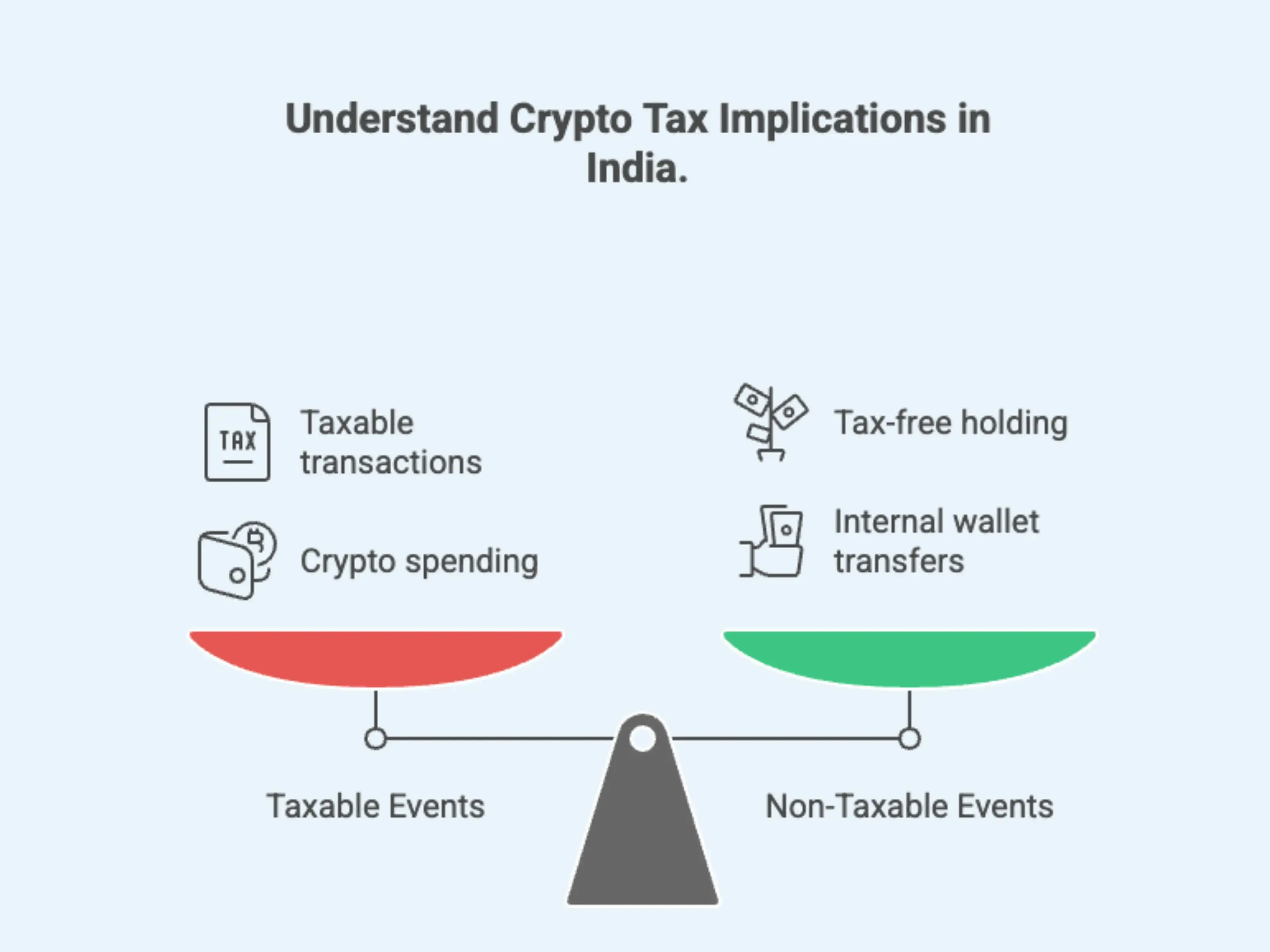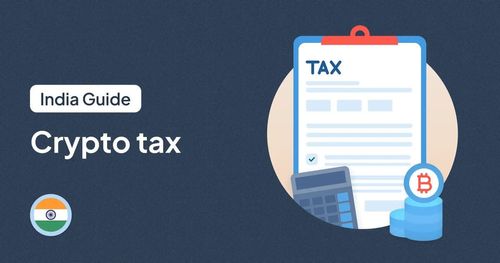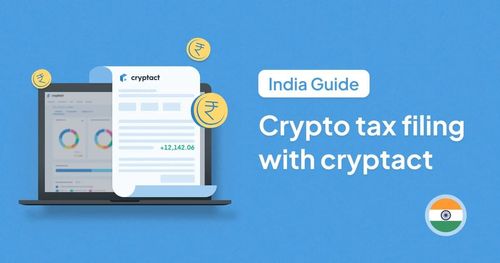
Cryptocurrency is gaining popularity among Indian investors, but with it comes complexity and cost, especially in the form of taxes. Since 2022, India has enforced a 30% flat tax on crypto gains, no loss offset rules, and a 1% TDS on transactions. For many, this creates confusion, tax inefficiencies, and missed opportunities.
If you're wondering how to minimize crypto tax India, you're not alone. Most crypto investors are unsure about what’s legally allowed, how TDS works, or how to track gains across exchanges and wallets.
This post is designed to change that. You’ll find actionable crypto tax saving tips for Indians, and understand exactly how current laws apply to you. Learn how a tool like cryptact can simplify tax planning, automate reports, and potentially save crypto tax India. Read on!
Table of contents |
No credit card required
Understanding Crypto Taxation in India (Why It’s So High)
Let’s begin with the tax fundamentals every investor needs to understand before applying any tips to crypto tax in India.
Key tax rules for crypto in India:
● 30% Flat Tax on Profits:
No matter your income slab, any gain from crypto is taxed at 30%: whether it’s a ₹500 or ₹5 lakh profit.
● No Offsets for Losses:
Unlike stocks, crypto loss harvesting is not permitted in India. You can’t offset one coin’s loss against another’s gain, limiting any crypto capital losses offset.
● 1% TDS on Every Sale:
A 1% tax deducted at source (TDS) applies on crypto transfers above ₹10,000 per year, even if the trade is at a loss.
● No Deductions Allowed:
Besides the original cost of acquisition, no other expenses (fees, gas, etc.) can be deducted.
● Additional Surcharges:
Gains may be subject to surcharge (for high-income individuals) and a 4% cess.
Taxable events and non-taxable events

India currently offers very few crypto tax exemptions, which makes smart planning essential.
Since every gain is taxed in full and losses don’t reduce your tax bill, the burden is real. But with the best ways to save crypto tax in India, you can still optimize within the law. Let's explore how.
Check out this article for more information on filing crypto taxes in India.
Why Tax Planning Matters for Crypto Investors in India
If you’ve searched for ways to save crypto tax in India, you already know the pain: high tax, strict tracking, and unclear compliance. Good crypto tax planning in India means organizing your trades and finances in a smart, legal way to reduce your overall tax burden.
Here’s why this matters:
● Avoid crossing surcharge thresholds by spreading gains across years or accounts.
● Use deductions (on salary/business income) to free up cash for tax dues.
● Avoid penalties by ensuring your TDS and VDA filings are clean.
In short, don’t leave your tax to chance or last-minute scramble. Let’s now get into crypto tax saving tips that every Indian investor can apply.
Seven Crypto Tax Saving Strategies for Indian Investors
1. Keep Detailed Records and Use Crypto Tax Tools
Poor documentation is a leading cause of paying extra tax. You must track:
● Buy/sell dates
● INR value at the time of transaction
● Asset amounts
● Exchange fees
● 1% TDS deducted
● Master wallet/account list to sync all transactions in tax tools
Manual tracking across exchanges and wallets is tough and prone to error. This is why using a tool like cryptact can make a huge difference. It imports your trades, calculates tax per Indian rules, and generates compliant reports.
2. Time Your Trades and Payouts Strategically
Yes, the tax rate is fixed but when you realize gains matters. Here’s why:
● Split big gains across FYs:
Sell part of your holdings before March 31 and part after to avoid jumping into surcharge brackets.
● Avoid gains in a high-income year:
If you’re earning big this year (e.g., bonuses), delay crypto selling if possible.
● No benefit from losses:
Since crypto loss harvesting isn’t allowed In India, selling loss-making assets does not reduce your tax bill. You also can’t use crypto losses to reduce tax, unlike other investment categories.
● Beware of budget changes:
Crypto tax policy may evolve. Stay informed of each Union Budget to adjust your plans.
This tip is all about knowing when to sell. Just like investing, tax timing matters too.
3. Understand Loss Harvesting Limitations
In most countries, you can offset losses to reduce taxes. In India: you can’t.
Losses on one crypto can’t:
● Offset gains from another coin
● Be set off against other income
● Be carried forward to future years
So if you’re considering a loss-making sale to save tax…stop. It won’t help. Focus your energy on other legal crypto tax saving tips for Indians instead.
4. Utilize Crypto Gifts and Family Transfers
Here’s a smart strategy many overlook: gifting crypto to family.
● Gifts to close relatives (spouse, children, parents, siblings) are not taxable.
● When the relative later sells the crypto, they pay the 30% tax (based on your cost).
● If they have lower income, you avoid surcharges.
This is a legitimate way to reallocate tax burden within the family. Just document gifts properly and avoid gifting to spouses if you want to avoid “clubbing” rules.
5. Consider Crypto Salary or Staking Income
Not all crypto income is taxed the same.
● Crypto Salary:
If you get your payments in crypto, it’s taxed as salary or professional income, not as VDA. That means slab rates apply instead of 30%.
● Staking/Mining Rewards:
Often taxed as “income from other sources” at slab rates. This opens opportunities for tax saving on crypto mining, especially for individuals in lower tax brackets. If you’re in the 5–20% bracket, this is far more tax-efficient than capital gains.
While you’ll still owe 30% if you later sell the coins at a gain, earning in crypto rather than trading it can reduce upfront tax.
6. Claim Your 1% TDS Credit (Don’t Overpay Tax)
This is one of the most overlooked crypto tax tips that investors in India might have missed:
Every time you sell crypto, 1% is deducted at source. You must:
● Track it
● Reconcile it via Form 26AS
● Claim credit while filing ITR
If you skip this step, you could be overpaying tax, sometimes by thousands. Especially if your trades were at break-even or loss.
7. Explore Tax-Efficient Crypto Investment Options
Direct crypto trades are taxed at 30%. But not all exposure to crypto is treated the same.
Consider:
● Bitcoin ETFs or foreign crypto index funds
● These are taxed as capital assets (20% with indexation, or slab rate for short-term)
You also:
● Can offset losses
● Avoid the 1% TDS
● Benefit from long-term holding incentives
If you're looking for the best ways to save crypto tax in India, exploring such alternative vehicles is a smart move, especially for high-volume or long-term investors.
Additional Information: Reducing Overall Tax Liability
It is also worth noting that while income from cryptocurrency is taxed at a flat rate of 30% with no deductions permitted against it, you may still reduce overall tax liability by lowering other components of your taxable income.
You can achieve this through eligible deductions under provisions such as:
● Section 80C (for investments in ELSS, PPF, and life insurance premiums, subject to a limit of ₹1.5 lakh),
● Section 80D (for health insurance premiums), and
● Section 80G (for donations to specified charitable institutions).
Furthermore, under Section 87A, individuals with a total income (including crypto gains) of ₹5 lakh or less may qualify for a full rebate, effectively bringing their tax liability to zero.
Conclusion: Streamline Gains, Stay Compliant & Use the Right Tools
Paying crypto tax in India doesn’t have to feel confusing or overwhelming. While the rules are strict, there are still smart ways to reduce your tax bill legally and stay fully compliant. By keeping good records, timing your trades well, using legal exemptions, and understanding how the system works, you can make better decisions that protect more of your profits.
The most common reason people overpay tax isn’t because they made big profits. It’s because they didn’t plan. Forgetting to claim TDS credit, not tracking costs properly, or filing late can all cost you money.
That’s why using a tool like cryptact can make a big difference. It helps you track every trade, calculate your gains, apply Indian tax rules correctly, and prepare reports you can file with confidence. It’s fast, reliable, and made for Indian crypto investors.
Don’t wait until the last minute. Start planning your crypto taxes now. Use cryptact to save time, reduce stress, and make sure you only pay what’s required.
No credit card required
FAQs
What are crypto tax saving tips?
Crypto tax saving tips are legal strategies that help reduce the amount of tax you pay on your cryptocurrency gains. In India, this includes tracking trades accurately, using crypto tax tools, spreading gains across financial years, gifting crypto to family, exploring ETF investments, and claiming your 1% TDS credit. While you can’t offset losses, smart planning can still lower your overall tax burden.
Can I offset crypto losses in India?
No, you cannot offset crypto losses in India. As per current tax laws, losses from one crypto trade cannot be set off against gains from another, nor can they be carried forward to future years. This means even if you made a loss on some trades, you must still pay 30% tax on your profitable ones. This rule makes tax planning even more important for crypto investors in India.
How to save tax on crypto gains India?
To save tax on crypto gains in India, you can:
● Use crypto tax tools to track and optimize your trades
● Time your sales to avoid high-income or surcharge years
● Gift crypto to family members in lower tax brackets
● Claim your 1% TDS credit properly
● Invest through ETFs or other capital asset routes where possible
● Use other deductions (like 80C, 80D) to reduce your total tax liability
These are some of the best ways to save crypto tax in India while staying compliant.
Are crypto tax tools available India?
Yes, there are several crypto tax tools available in India, and one of the most reliable is cryptact. These tools can automatically import your trades, calculate gains based on Indian tax rules, apply TDS credits, and generate reports ready for ITR filing. They help save time, avoid errors, and ensure full compliance with Indian crypto tax laws.
What is India crypto TDS?
India crypto TDS refers to the 1% Tax Deducted at Source (TDS) that applies to most crypto transactions above ₹10,000. It is deducted by the exchange or buyer at the time of sale, regardless of whether you make a profit or not. You can claim this TDS amount as credit when filing your income tax return, reducing your final tax liability.





